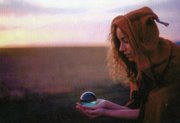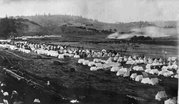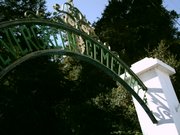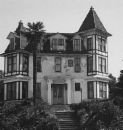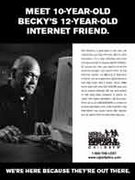HISTORICAL MEMORIES HAUNT BROOKDALE LODGE
Historical Memories Haunt Brookdale
by Ross Eric Gibson
A girl in a formal dress runs across the lobby, then disappears into thin air. In an empty Mermaid Room, voices and music are softly heard. Hidden rooms and secret passages are mysterious vestiges of Brookdale Lodge's rich past.
Brookdale, two miles south of Boulder Creek, opened in 1900 when the Grover lumber mill was purchased by Judge H.J. Logan, originator of the loganberry. The extensive acreage became campgrounds and summer cabins, with the mill's log- lodge headquarters from 1870 converted into a hotel. A bridge over nearby Clear Creek led to the small dining hall, which overlooked Minnehaha Falls.
After Dr. F.K. Camp purchased the site, the river changed course in 1922, cutting a channel through the hotel grounds. Embankments were needed to keep the creek in its place, but Camp felt they shouldn't detract from the stream bed's natural appearance. The resulting terraces lined with granite boulders suggested a marvelous setting for dining, and Camp envisioned a dining hall straddling the fern-lined creek.
This vision was carried out by architect and landscaper Horace Cotton, whose design gained critical acclaim among architects for so deftly integrating a rustic structure into the very fabric of the forest. It was ranked with Yosemite's Ahwahnee Lodge as that rare example of serious "rustic style" architecture.
The large barnlike structure resembled a redwood log cabin, with whole-log verandas decorated in sticks of "tanglewood gingerbread." Inside, the terraces were supposed to protect the lodge from rising water. For 70 feet, the creek passed through the dining room, under a large atrium skylight that allowed continued growth of the woodwardia and other ferns. Trees growing through the roof formed a natural canopy.
In a back wall above the rustic bridge over the falls was a round window, lit at night to look like moonlight through the trees. Here a woman sang "Indian Love Call" opening day, on what became known as the Honeymoon Bridge. Horseshoes from the old mill were welded together as lanterns. Even the stream was lit, with colored underwater lights (a device perfected by architect Cotton), and people could watch trout swimming by as they dined. And the kidney- shaped pool (lit from below) later had an underwater window behind the Mermaid Room bar.
Cotton also remodeled the 1870 lodge into a lobby and reading room. New entry doors went up, each four inches thick, 51 inches wide and weighing 300 pounds. Their ornamental hinges were cut out of the mill's scrap boiler plate. The river-rock fireplace had a 6-foot tall opening, and the chandeliers were rounds of polished burl hung with lit clusters of pinecones.
Camp, a Seventh-day Adventist physician, was a strict prohibitionist. So even the end of Prohibition didn't end his habit of sniffing the customers' drinks, and pouring out liquor into the brook. Yet in spite of his idiosyncrasies, Camp's era from 1924 to 1945 was the golden age for the lodge. He ran it as a first-class retreat, attracting international celebrities, Hollywood stars, presidents and kings. Shirley Temple and Johnny Weissmuller had homes nearby. Herbert Hoover visited often, and enjoyed fishing off the dining room bridge. And during the San Francisco conference establishing the United Nations, world leaders and diplomats came to the lodge to relax.
Brookdale was also a popular host of famous bands and singers of the swing era. At least three songs were written about the lodge, such as "My Brookdale Hideaway," "A Place Known as Brookdale" and "Beautiful Brookdale Lodge." The last was an Ink Spots tribute, which will be performed at an upcoming Actors Theatre revue in Santa Cruz.
The lodge changed hands in 1945, shortly before Camp's death. The twin evils which Camp had successfully kept out during his ownership -- booze and gangsters -- now became familiar fixtures in a lodge falling rapidly into disrepair. Secret passageways and hidden rooms filled the lodge, and there were rumors of mobsters having buried a body under the floor. The capper for this shady era was when the niece of the lodge owner drowned in the dining room creek. Sightings of her ghost have been reported ever since.
Barney Morrow, who bought the lodge in 1951, remodeled it after a 1956 fire destroyed the dining hall. He called his design a "Hansel & Gretel theme motel," transforming the redwood buildings into a mock-French Tudor and "Santa's Village Swiss" hybrid. Most of the campground was paved for a massive parking lot, bordered by a barracks-like motel wing, the only one built of five planned cinder-block wings.
Current owners are conducting a more sympathetic restoration of the lodge. In 1990, real estate investor Bill Gilbert and his family paid $2 million for the lodge and surrounding eight acres, and are refurbishing 46 motel rooms, the Brook Room and the lounge, which are open for business.
This article originally appeared in the San Jose Mercury News, October 19, 1993. Copyright 1993 Ross Eric Gibson. Reprinted by permission of the author. Post cards are from the Santa Cruz Public Libraries' collection.
Disclaimer: It is the Library's intent to provide accurate local history information. However, it is not possible for the Library to completely verify the accuracy of individual articles obtained from a variety of sources. If you believe that factual statements in a local history article are incorrect and can provide documentation, please contact the Webmaster.
Local History Santa Cruz Public Libraries' Home Page







